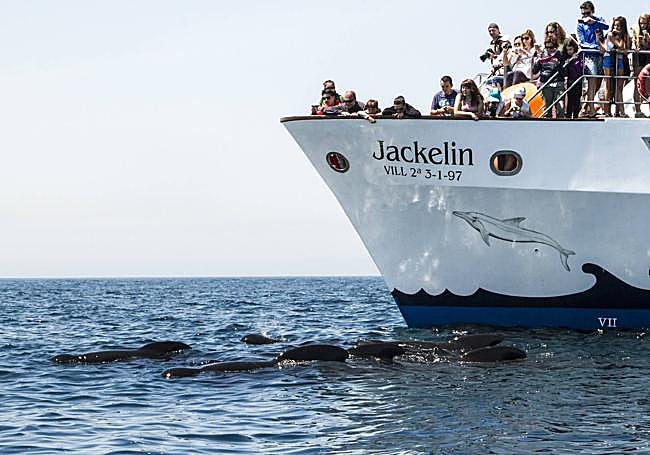An afternoon of wind, waves and whale-watching
Meet the dolphins: the Gibraltar Strait is home to seven cetacean species; specialised and educational excursions from Tarifa take visitors out to look for them
Anna Clift
Friday, 7 July 2023, 19:48
Tarifa, the most southern point of continental Europe, is known for its large windy beaches, making it a paradise for those interested in windsurfing and water sports. Nevertheless, there is another water-based activity offered in Tarifa which doesn’t involve getting into a wetsuit: whale and dolphin watching.
Turmares is one of the companies in Tarifa offering sea excursions to spot marine mammals. The company was founded 24 years ago and continues to attract both international and Spanish visitors throughout the season which runs from March to October.
Walking down to the Turmares office, the meeting point for the trip, I pass through Tarifa old town, a labyrinth of idyllic white streets. It is a sunny day with clear blue skies and a temperature of 24 degrees. Arriving at the office, staff print my boarding pass and direct me to the air-conditioned waiting room where people are beginning to gather.
At about quarter to four, we are led out to the boat, which is called Pirata. It has a capacity for 62 people and is fitted with rows of benches, some inside and some outside with a cover, as well as a small front deck for observation. The other main boat used for trips is Jackelin, which is much bigger with a capacity for 195 passengers. This boat also has a bar and a striking underwater observation feature.

We set out from Tarifa at 4pm and head into the Strait of Gibraltar. The breeze is refreshing and the bouncing of the boat as it picks up speed is exciting. The sea is choppy, which one of the crew members explains is not only due to the wind but also the many cargo ships on the water, which are quite a unique sight themselves. The guide encourages those feeling adventurous to stand on the front deck, but warns that this entails a risk of getting splashed.
About thirty minutes into the trip the boat engine is turned off and people start to look around with anticipation. The guide tells us to look to the left, causing everyone to rush to the side of the boat in excitement. And there they are. A group of common pilot whales, just metres from the boat. They come up from the water in a slow elegant motion. Contrary to the name, this is a species of dolphin, which is distinguished by its dark colour and hook-shaped fin.

After giving everyone time to admire the common pilot whales, the boat picks up speed again as we continue our quest to spot more marine mammals. Just five minutes later, we draw to another stop as a small group of bottle-nosed dolphins arise at a distance, making impressively large jumps. The guide explains that this is one of the most common species found in the strait, and that they are particularly active and acrobatic.
Soon after, we see a second pod jumping in and out of the water, this time much closer to the boat, which causes great excitement for everyone on board. These are mostly striped dolphins with some common dolphins. The reason they come so close is because they use the motion from the boat to save energy while swimming.
The guide on the trip is Candela Sánchez Atienzar, a 36-year-old Tarifa-born marine biologist. Throughout the trip she tells us interesting facts in both Spanish and English about the animals we are seeing. Candela tells me that she has spent most of her life in Tarifa and as a child “I would always have my birthday parties on boats”. She has been working at Turmares since 2019, and adds, “I love my job.” Her passion for marine biology can be seen by the expression on her face as she takes photos of the dolphins: “Look how beautiful they are.”
Talking about the profile of customers, she says, “We get a mixture, although naturally throughout the summer months there are a lot more international tourists. But we also have a fair amount of Spanish customers, as they often haven’t thought before about exploring what is so close to them.”
This is confirmed by those on the trip. There are families with babies, couples, and students speaking a variety of languages, demonstrating that this really is an activity that anyone can enjoy.
Turmares runs “two trips every day weather conditions permitting”, Candela explains, adding that strong winds can lead to cancellation, but this is not a common occurrence. The excursions are normally two hours long, but between July and September the company also offers a third longer trip, which is three hours. During this trip the boat goes further out towards the Morocco coast for a chance of seeing orcas, more dramatically known as killer whales.

We continue to cruise across the Strait of Gibraltar, as we are told there is a chance of seeing a sperm whale. Unfortunately, after a while it seems the odds are not in our favour today, and we begin our return. Nevertheless, spirits are high as we have managed to see four of the seven cetacean species in the strait. Turmares prides itself on a 95% chance that you will see at least one species during the trip. If not, then you are offered a second trip for free.
As we pull into the harbour at around 6pm, the sun is still shining. Ending the day with a walk along the breathtaking Playa de los Lances confirms that a day out whale watching in Tarifa is a great idea for those visiting Andalucía over the summer and wanting to experience something unique.
More information
-
Website Visit www.turmares.com



